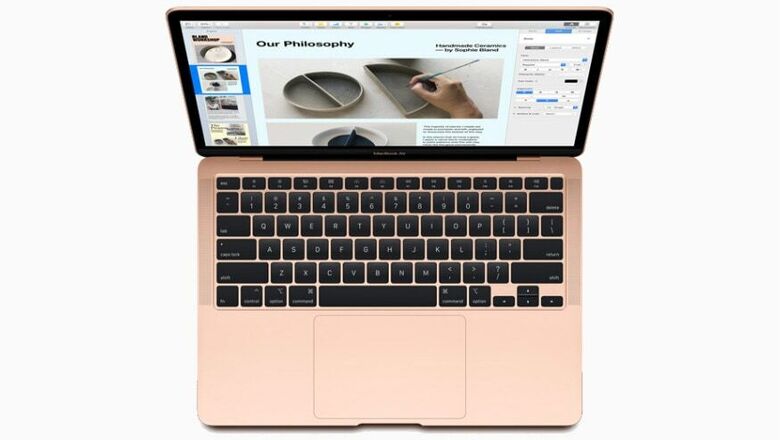
views
It has been doing rounds for a while now. There has been this simmering expectation for a while now that Apple would eventually swap the Intel processors in their Mac computing line-up, that includes the MacBook Air, the MacBook Pro, the iMac, Mac Pro, iMac and the Mac Mini. The idea being to replace them with their own chips. In a way, emulate the successful iPhone and iPad model, where the hardware and software are fully controlled by the company, to deliver what is a superior experience than what components and software cobbled together can often manage. We first heard that Apple could replace the Intel chips with their own chips in Macs almost 2 years ago, and many estimates expected this switch to happen this year. Let’s just say that those estimates then were correct, but the Coronavirus pandemic and the resulting production as well as larger economic challenges around the world, have perhaps delayed the inevitable. Till next year.
That theory is given credence by the latest report in Bloomberg, which suggests that Apple is indeed moving forward with the development of as many as three variants of processors that may power Mac devices soon. These will be based on the A14 chip that is expected to power the next Apple iPhone. The project is codenamed Kalamata. The report suggests that Taiwan Semiconductor Manufacturing Co., who also make chips for the Apple iPhone and iPad, will be making the new Mac processors as well.
But why would Apple want to do this?
For years, Apple has differentiated the experience of using an iPhone and an iPad on the greater control it has over the marriage of the hardware and the software. That has worked well for them, because it allows full control over each aspect. The other big winner is security. The underlying similarities between the iPhone and the iPad has allowed iOS and now iPadOS to take better advantage of the ecosystem as a whole. Made life easier for developers as well. Getting Macs, with the macOS into the same fold, will allow it to truly unify its hardware and software ecosystem.
Secondly, Intel is now no longer really able to offer the sort of performance upgrades that it once did. Both in terms of core performance, higher clock speeds and integrated graphics. Can’t exactly blame Intel for it, because computing devices are incredibly powerful whichever way you look at them—editing multiple streams of 8K videos is no joke. But incremental updates don’t make for an enticing proposition when it comes to the hard task of convincing someone to buy a new MacBook or iMac. Which has been a problem for Apple, and the Mac updates have not been as exciting as they used to be, at least in the past few years. We really need that to change.
A sub-plot on this also is the architecture. The smaller the processors get, the more power efficient they become. Intel has famously struggled in this pursuit of a smaller size with its chips. The latest gen, the 10th generation Intel Core processors celebrated the move to the 10-nanometer process from the 14-nanometer process, something the company has been using since 2014. Apple’s own A13 Bionic chip for the iPhone 11 and iPhone 11 Pro series runs the 7-nanometer process. So does the A12X which powers the iPad Pro. Not only is there a performance variation, but could mean the difference between 12 hour battery life and 20-hour battery life in laptops.
Then there is the matter of customization. Apple, if it has control over its own chips, will be able to order them exactly as it wants them. For instance, the latest iPad Pro is powered by the A12Z Bionic chip with a Neural Engine and an embedded M12 coprocessor. This eight-core processor uses four cores for performance intensive tasks, while the other four are utilized at other times for simpler apps and tasks to save on battery. This is where the full control over hardware and software comes in handy—Apple can dictate exactly what the hardware will do to specific requests from iOS, iPadOS and macOS, and how the software drives the experience in the process. When you buy a chip from someone else, Intel in this case, yes there can be a customization to a certain extent based on specific requirements for computing devices they intend to power, but that has its own limitations.
Apple could look at more than 12 cores, for instance, for their higher end Macs, designed for professionals. The current MacBook Air has the dual core Intel processor—something that the macOS software compensates for, but most certainly a disadvantage on the spec sheet.
We don’t know as yet which of the existing Mac line-up would be the first to get Apple’s own chips. Or whether it will be an entirely new machine that will be launched to introduce the new processor generation. It is unlikely that Apple will switch to the new processors across the board, in one fine swoop. Maybe we could see the return of the 12-inch Apple MacBook? If only wishes came true ever so often!
It seems that the journey which started back in 2015 when Apple Co-founder, the late Steve Jobs and the then Intel Chief Executive Officer, late Paul Otellini, took to the stage to announce a partnership that really had a great run over the years—including the ultra-thin MacBook Air and the original Mac Pro. It is perhaps the right time to part ways now.
















Comments
0 comment